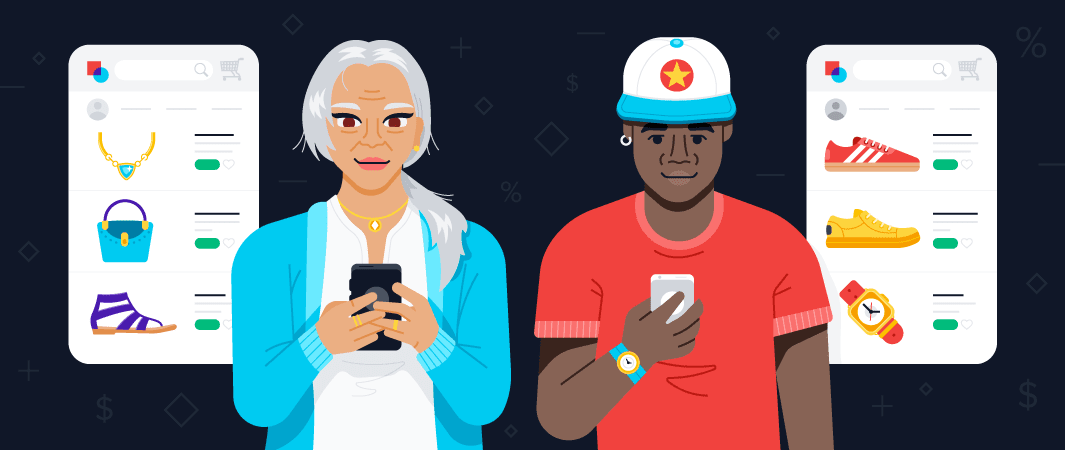
Personalisation in Ecommerce: How To Get Started
By Lavender Nguyen (originally published on Salsify)
APRIL 14, 2022 | 7 min read
Do you have a personalisation strategy in place? If not, you may want to reconsider.
Salsify’s “Consumer Research 2022” report found that 70% of U.S. shoppers are more likely to buy if there are personally relevant images, videos, text, and reviews on a product page.
That’s too significant a number to discount the value of personalisation.
Personalisation in ecommerce helps provide customers with meaningful offers — while improving retention and boosting your brand’s conversions.
Here are some tips on how to introduce personalised experiences throughout your direct-to-consumer (DTC) website.
1. Understand Your Target Audience
A successful ecommerce personalisation strategy requires a deep understanding of each customer’s needs, expectations, and behaviours.
“Instead of crafting campaigns around ‘How can we sell a product that people will buy,’ try ‘How can we sell a product that *this customer* will love and enjoy’,” says Kristen LaFrance, ecommerce expert and director of community at Repeat.
To do that, you need to start collecting data about your target audiences.
Think beyond generalised information like name, gender, age, or occupation, because your customers aren’t demographics — they’re individuals.
Collect Critical Data
The more you know about each of your customers personally, the better ideas you’ll have for your ecommerce personalisation strategy.
Start by identifying their different interests, preferences, desires, shopping habits, and buying intentions.
Figure out what makes them purchase from your brand, share about you on Instagram, return products, etc.
Website personalisation takes into account:
- Real-time behavioural data;
- Individual user profile data;
- Data ingested from other channels; and
- Cookie-based historical data.
We can expect a shift in how ecommerce teams use real-time behavioural data in the following years, as a result of changes in how customer data can be captured and used due to the General Data Protection Regulation (GDPR), California Consumer Privacy Act (CCPA), and “Cookiepocalypse.”
Once you have the necessary data, the next step is to find a platform that allows you to centralise all this information in one place. This ensures that data is consistent, accurate, and up-to-date across channels.
2. Determine What You Should Personalise
There are many different ways for a brand to implement personalisation in ecommerce.
For example, you can personalise:
- Ad creatives;
- Emails;
- Product recommendations;
- Customer service offerings; or
- Mobile experiences.
The key is to identify what types of personalisation are valuable to your customers — and run A/B tests to find out what actually works.
Explore Different Personalisation Tactics
The subscription dog food brand Scratch has applied several personalisation tactics to their ecommerce website.
For example, when you visit their site, you’ll see a pop-up asking when you want to receive a refill reminder.

Image Source: Scratch
You can also take a quiz to learn what type of food is best for your dog. Just answer a few questions about your dog’s name, sex, weight, size, date of birth, etc., and you’ll receive recommended recipes.

Image Source: Scratch
Notice how the brand includes the dog’s name in the conversation (in this case, my dog’s name is Lin).
This is a great way to assure customers that the suggested products are what best suits their dog — increasing the chance they’ll make a purchase.
Here are some other tactics you can use to deploy personalisation in ecommerce.
Personalise Your Homepage
Personalise each customer’s homepage experience with different sales offers, banners, and other embedded imagery that could change depending on how they interact with your brand.
For example, if a first-time customer lands on your DTC site and shows their interest in the women’s category, you can direct them to a women-focused homepage the next time they visit.
Create Specific Targeting Campaigns
Consider developing targeting campaigns based on specific user behaviours.
For example, if a customer abandoned an item, you can send them an abandoned cart email displaying the exact item they’ve left.
You can also offer them a discount with a unique coupon code, making the customer feel special and valued.
3. Connect With Relevant Stakeholders and Get Their Buy-In
Personalisation isn’t just about marketing; it also involves the sales, customer service, supply chain, and product development teams.
You’ll need strong buy-in from all relevant internal and external stakeholders.
Consider the following tips when approaching stakeholders.
Tailor Your Personalisation Pitch
Alter your personalisation pitch depending on how familiar each stakeholder is with personalisation and their expertise.
This way, you can deliver what they want to hear and help them understand their contribution to the whole plan.
Start Small
Start with a small scope before you scale up. No matter how exciting personalisation may seem, you can’t do it all at once.
You can start with testing emails or product recommendations. Then, identify the group of people who will be involved in the process and run A/B testing.
When you see positive results, repeat the process on a larger scale.
Set Goals
Goals, objectives, and key performance indicators (KPIs) should be tailored to each channel on which you’ll implement personalisation.
Segment Audiences
Segment audiences based on the customer data you’ve collected.
You can segment based on website interactivity, purchase history, frequency, product categories, etc.
Brainstorm Personalisation Ideas
Brainstorm personalisation ideas based on your goals, objectives, and custom segments.
Then, sort through these ideas to identify the ones that are likely to bring in the most value in the shortest amount of time.
Choose a Personalisation Technology
Choose a personalisation technology that will help you keep track of customers’ activities on your DTC website, provide insightful analytics, and implement personalisation at scale.
Make Personalisation in Ecommerce a Core Business Priority
Today’s customers are on the hunt for product offerings that meet their unique, evolving needs.
As a result, personalisation has gone from a “nice-to-have” offering to an increasingly critical tactic for ecommerce success.
Try our four tips to start personalising your customer experiences, and see how your growth will skyrocket.
Download Salsify’s “Complete Product Page Toolkit” to learn more about how to develop product pages that meet your customers’ personalisation needs.



